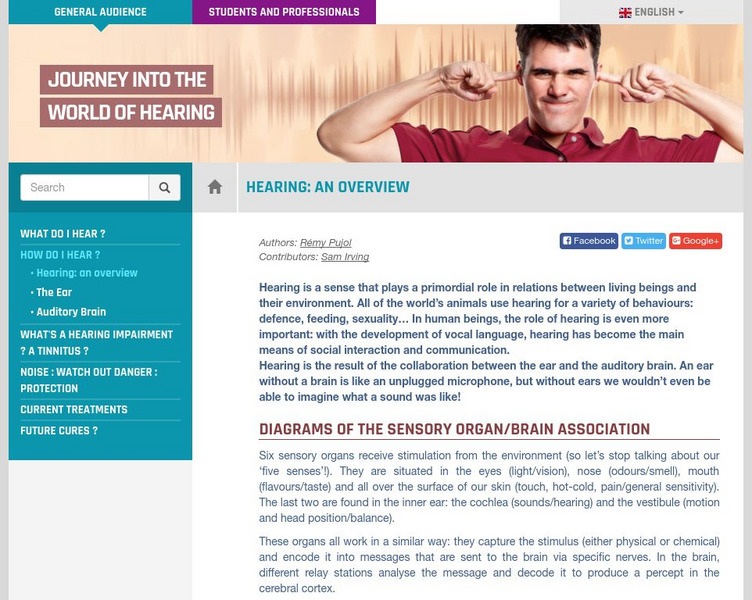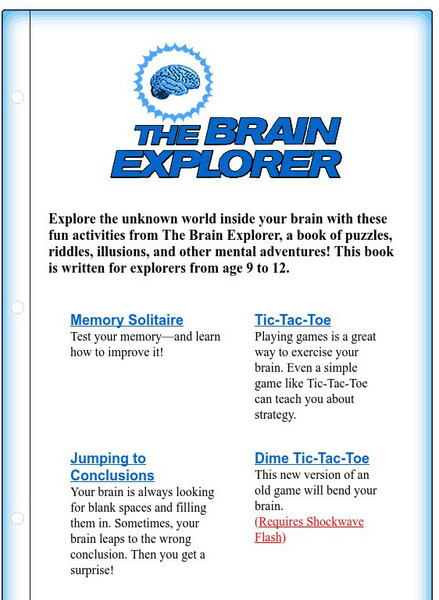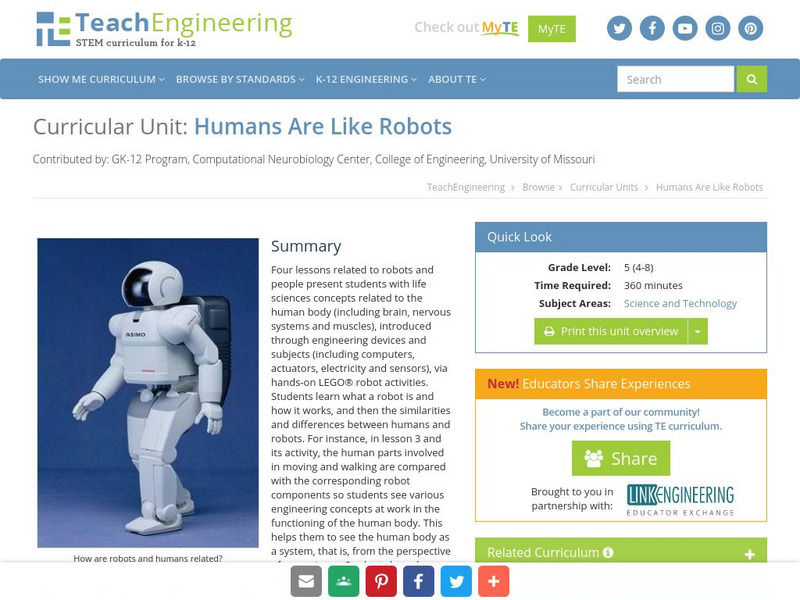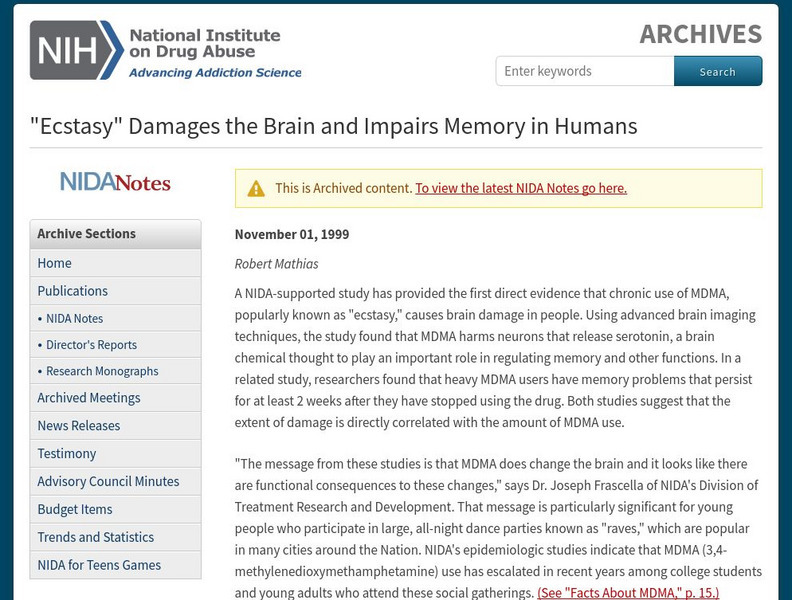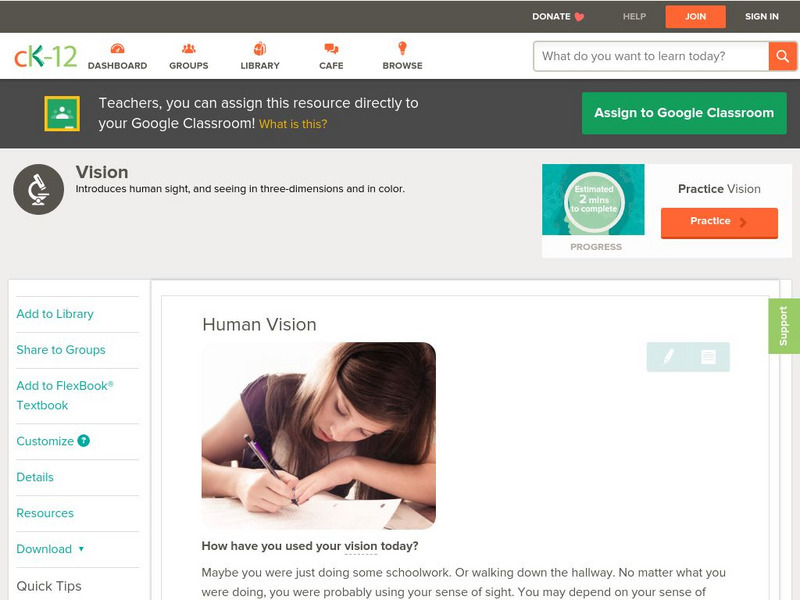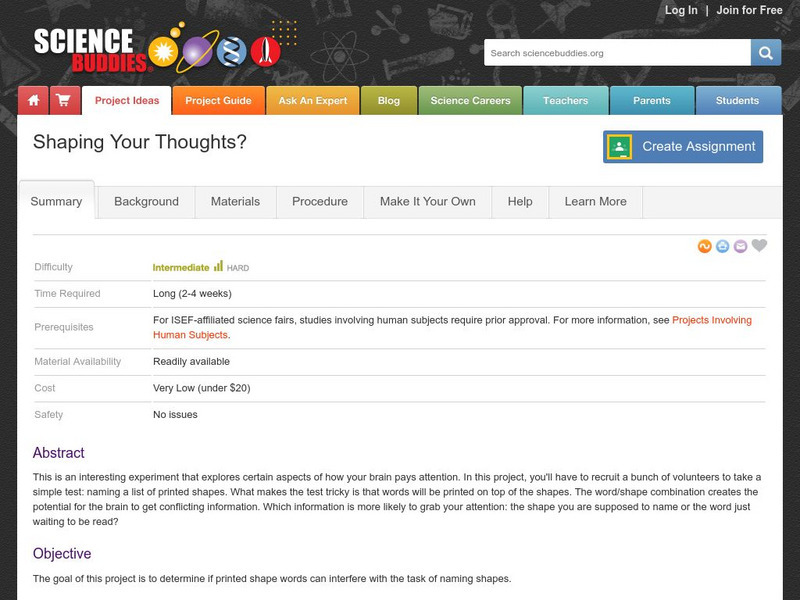Hi, what do you want to do?
McGraw Hill
Glencoe: Biology: The Nervous System Post Test
A five-question multiple-choice quiz assessing the topic of the central nervous system of the human body.
TED Talks
Ted: Ted Ed: The Difference Between Classical and Operant Conditioning
Peggy Andover explains how the brain can associate unrelated stimuli and responses, proved by Ivan Pavlov's famous 1890 experiments, and how reinforcement and punishment can result in changed behavior. [4:13]
Frontiers Media
Frontiers: Thanks for the Memories
Everyone wants a good memory but we don't often ask ourselves what memory is for. Let's begin our exploration of why memory is important and how it works with a little memory test: Do you remember what you learned in class last...
Other
Get Body Smart: General Organization of the Nervous System
Brought to you by Get Body Smart, students can learn about the human nervous system through this easy-to-access tutorial. Sections include Major Organs and Divisions, Sensory and Motor Divisions, Somatic Divison, Sample Somatic Divison...
NeurOreille
Neur Oreille: Journey Into the World of Hearing: How Do I Hear?
See how the human ear senses a sound, and how that stimulus is transmitted to the brain for interpretation and response.
CommonLit
Common Lit: Text Sets: Science of the Body
Introduce students to how the body looks and works with these texts on biology and genetics. This collection includes 20 Grade-Leveled texts (5-10) on the topic of Science of the Body. [Free account registration required for specific...
National Institutes of Health
National Institutes of Health: The Brain: What's Going on in There?
Do you know all the activities your brain controls? This website explores brain images, brain anatomy, and PET procedure to allow students to get a better understanding of the brain. The website contains interactive activities and videos...
Frontiers Media
Frontiers: Brain Projects Think Big
When you read these words, hundreds of millions of nerve cells are electrically and chemically active in your brain. This activity enables you to recognize words, sense the world, learn, enjoy and create new things, and be curious about...
Exploratorium
Exploratorium: The Brain Explorer
Six games and puzzles taken from a book published by the Exploratorium, The Brain Explorer.
TeachEngineering
Teach Engineering: Humans Are Like Robots
Four lessons related to robots and people present students with life sciences concepts related to the human body (including brain, nervous systems and muscles), introduced through engineering devices and subjects (including computers,...
Science Buddies
Science Buddies: Warped Words and the Stroop Effect
The Stroop effect describes an experiment about the time it takes to name the color of printed words. When you try to name the color in which color words are printed, it takes longer when the color word differs from the ink color than...
University of Washington
The Senses
This site has a collection of learning activities, games, experiments, and lesson plans on the five senses. Organized by grade level and topic, this site is packed with an assortment of interactive and engaging activities, that would...
PBS
Pbs Teachers, Nova: Little People of Flores: Compare the Brains
Compare and contrast the shape and size of a Homo floresiensis brain with the brain of a chimp and a modern human.
TED Talks
Ted: Ted Ed: What Is Dyslexia?
Kelli Sandman-Hurley urges us to think again about dyslexic brain function and to celebrate the neurodiversity of the human brain. [4:35]
National Endowment for the Humanities
Neh: Edsit Ement: Fear and the "Dagger of the Mind"
This lesson plan accompanies a reading of Shakespeare's Macbeth and lets students explore Macbeth's "response to fear" through studying metaphor, imagery, and dramatic cues and by performing a scene.
Other
Wisewire: Grade 3 Playlist: Identifying Real Life Connections Between Words
Often, without even realizing it, readers are connecting the words they read to their everyday lives. The human brain is moving so fast that even while reading, behind the scenes, readers are making connections to their real lives and to...
National Institute on Drug Abuse
Nida: "Ecstasy" Damages the Brain
This article summarizes a medical study that examined ecstasy's effect on brain function. Learn how this designer drug causes both short term and long term damage in users' brains.
A&E Television
History.com: How Early Humans Survived the Ice Age
The most recent ice age peaked between 24,000 and 21,000 years ago, when vast ice sheets covered North America and northern Europe, and mountain ranges like Africa's Mt. Kilimanjaro and South America's Andes were encased in glaciers. At...
Massachusetts Institute of Technology
Mit: Open Course Ware: Courses: Brain Cognitive Science: Cognitive Neuroscience
College-level online neuroscience course focusing on human memories. Course highlights how memories are created and controlled, and how we are able to remember the past. Course features include readings and related resources on the topic.
CK-12 Foundation
Ck 12: Life Science: Human Vision
[Free Registration/Login may be required to access all resource tools.] Sight, or vision, is the ability to see light. It depends on the eyes detecting light and forming images. It also depends on the brain making sense of the images, so...
Khan Academy
Khan Academy: Cocaine Addiction in Mice
Read this passage and answer the five-question quiz to tests your knowledge on drug addiction treatments.
TED Talks
Ted: Ted Ed: Can You Solve the Passcode Riddle?
In a dystopian world, your resistance group is humanity's last hope. Unfortunately, you've all been captured by the tyrannical rulers and brought to the ancient coliseum for their deadly entertainment. Will you be able to solve the...
Science Buddies
Science Buddies: Pinocchio's Arm: A Lie Detector Test
You might be surprised to learn that you have been practicing skills closely tied to lying if you have ever seen someone in pain, or mimicked your favorites sports athlete. In this science fair project, you will discover how your brain...
Science Buddies
Science Buddies: Shaping Your Thoughts?
This is an experiment that explores certain aspects of how your brain pays attention. In this project, you'll have to recruit volunteers to take a simple test: naming a list of printed shapes. What makes the test tricky is that words...








